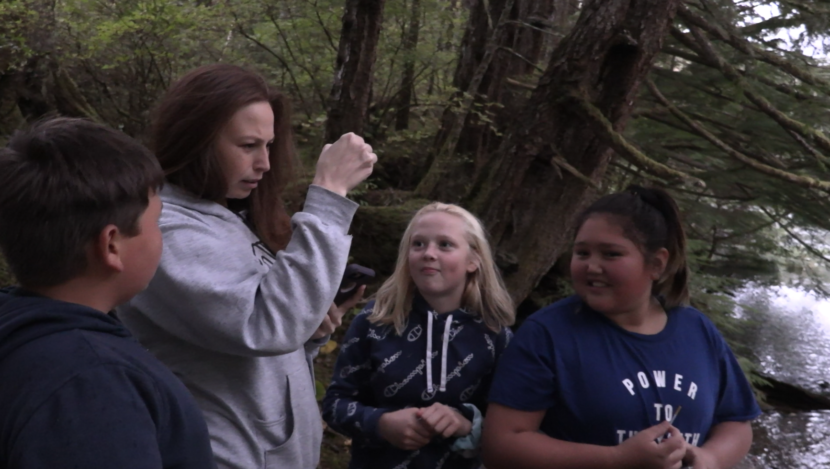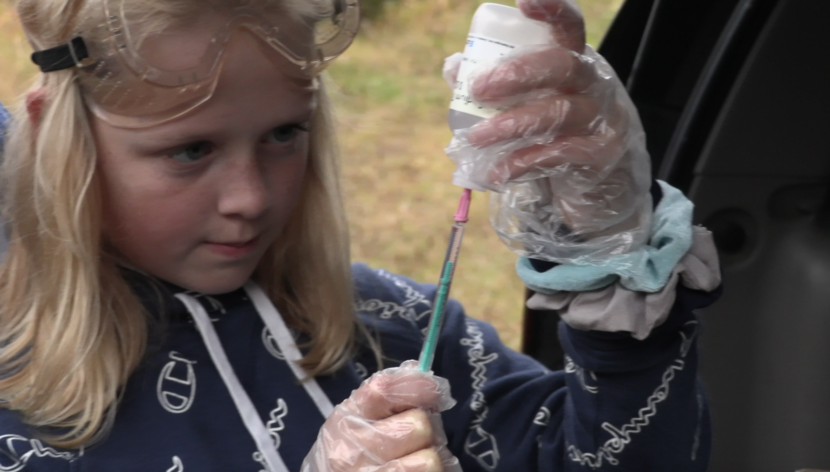
Ocean temperatures were well above average for much of the state this year.
And fish biologists throughout Southeast Alaska are monitoring salmon streams carefully. There are questions about how warm water and abnormally dry conditions could affect salmon returns.
In Metlakatla, a group of young scientists are logging their own data to better understand the future they’re inheriting.
On the trail to Hemlock Creek, the Boys & Girls Club members were nervous about running into a black bear. The forest is thick with trees and brush.
But Sesilynn Schleusner, the club manager, knows how to put the kids at ease. She lets out a loud whistle.
There were no bear sightings on the rugged path to the stream. But a curious seal popped its head out of the water to examine the adults and three preteens standing on the shore.
Schleusner takes this group here about once a week during the school year to test the water. They’re part of GLOBE, a NASA program which has trained over 100 teachers and mentors in Alaska since 1996 to engage students in science questions.
The Boys & Girls Club in Metlakatla has collected water samples from two salmon streams since 2018. The kids collect data on water temperature, pH and dissolved oxygen levels — that’s what helps salmon breathe through gills. But when the water temperature warms, dissolved oxygen decreases. It can kill fish or make the streams less desirable for returning salmon.
Both streams the club monitors have seen low salmon returns for the fish that spawn during even years. And these kids want to know why.
Mia Winter, 11, said that’s something on her mind.
“Almost everyone here fishes, or almost everyone in someone’s family fishes that lives here,” Mia Winter said.
Mia Winter’s uncle, Dustin Winter, also wants to know more about the health of salmon streams.
“We need our salmon runs to be strong, so we can survive here in Metlakatla,” he said.
Dustin Winter is the director of Metlakatla’s Department of Fish and Wildlife, which manages the Annette Island Reserve’s fisheries. A few years ago, the department started tracking salmon streams in the area by measuring water levels and temperatures in creeks.
Winter thinks the recent drought that’s played out in Southeast Alaska is likely contributing to fish numbers, overall, being down. He said biologists need more long-term data to fully understand how the ecosystem is changing.
Still, he thinks it’s “definitely related” to the drought.
“We can see it specifically in that one system we’re talking about now,” Winter said. “Water levels are down to just a trickle. In one case, we’ve had water temperatures as high as 80 degrees.”
Normally, water levels are a flow — not a trickle. Optimal temperatures for salmon production are around 40 or 50 degrees. But with warmer conditions, there’s less dissolved oxygen. Salmon have a tougher chance at survival.

Back at Hemlock Creek, the kids at the Boys & Girls Club rushed to the van to start testing a vial of water for dissolved oxygen.
Mia Winter put on goggles and gloves to handle the chemicals she carefully added to the water. In total, there are about 13 steps she has to follow to get the data.
“It’s hard to do that, because you can’t mess it up at all or you’ll mess up the whole entire thing,” she said.
But Winter didn’t mess it up. She handled the experiment with the cool demeanor of a scientist.
The dissolved oxygen levels in the creek looked pretty good that day.
On the drive back to the club house, Sesilynn Schleusner said she’d like these kids to continue collecting the research throughout high school. Contributing to the NASA program in their young years could be just the beginning.
“I’m hoping that it really gets their foot in the door to get in with a good natural resources program and bring what they learned back home,” Schleusner said.
After all, it’s a home they’ll come back to as oceans continue to change.
This story was supported by a grant from the Robert Wood Johnson Foundation.
